Link Building is the practice of increasing the quantity and quality of external links pointing to your site. This is one of the most important skills for SEO practitioners to master since links play such a huge role in search engines algorithms. In fact, backlinks are by far the most important ranking factors for almost every modern search engine.
Baidu is no exception — to rank highly, sites will need to attract as many high-quality, relevant links to their site as possible. Link building strategies typically begin with content creation, followed immediately by the promotion of created content to maximize backlink acquisition.
In this chapter, we’ll take a look at how link building for Baidu is different from Google, and share plenty of tips and strategies on how to acquire the kind of backlinks that will give you the most benefit on Baidu.
Just a few years ago, it wasn’t uncommon for even some of the biggest brands in the world to engage in unnatural link building — paying for links, building link networks, or other black hat SEO techniques (also known as link spam). With the introduction of their Penguin algorithm update in 2012, Google has gotten much more effective at discovering these techniques and penalizing sites that utilize them, which has lead to a massive decline in unnatural link building.
Unfortunately, while Baidu has put a great deal of effort into refining their algorithm to crack down on link spam, they are ultimately far less successful than Google. As a result, a high percentage of sites ranking highly on Baidu still engage in unnatural link building tactics.
The omnipresence of link spam in China has gotten so severe that many SEOs believe the only way to compete for Baidu rankings is to engage in spammy link building techniques themselves. Most sites find obtaining high-quality links from authoritative sites very difficult, so instead rely on creating high quantity of low-quality backlinks. It becomes a nuclear arms race of link spam, resulting in a very negative reputation for the term “SEO” in China.
This makes the Chinese web a very different place than you might be used to. It’s not uncommon to see unnatural links that are clearly only meant for SEO purposes that do nothing to improve the user experience. Further exacerbating the problem is that Baidu will consider URLs in plain text as backlinks, so you’ll see this exploited in user generated content areas such as comments and forums, even when links are not allowed.
Sadly, even in 2017 many old school link spam tactics remain extremely common. Let’s take a look at some of the most popular practices still used today in China.
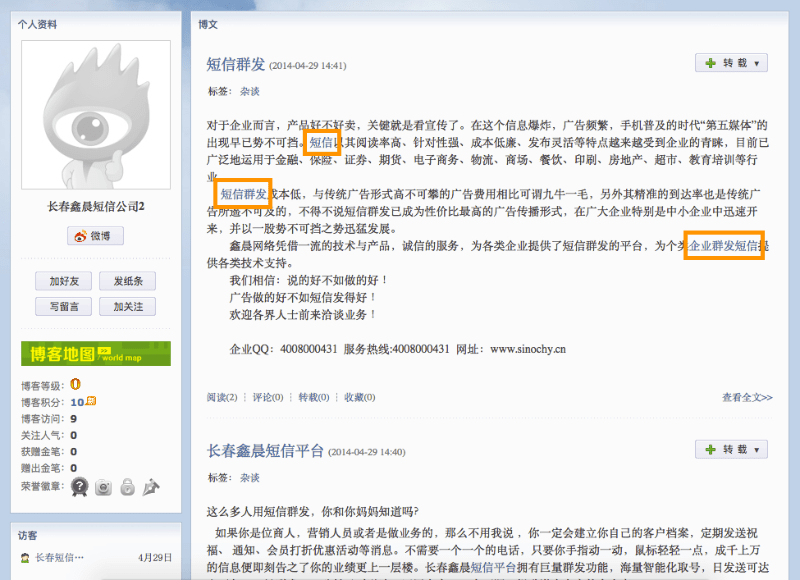
Link builders in China will create blogs on blogging platforms like Sina, Tianya, Sohu, or 163 for the sole purpose of publishing large amounts of content with links back to their site.
Due to the high popularity of these platforms, Baidu tends to index these content very quickly. One unfortunate consequence of this is that scraped content posted to these platforms may be indexed faster than the original, leading to scraped content outranking the original post. This is a very common and unfortunate problem in China.
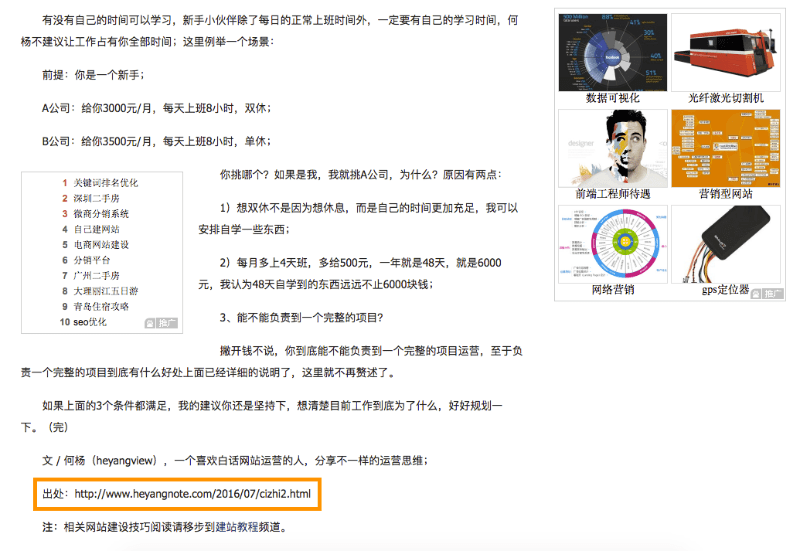
Many websites will accept content submission that contain links in plain text (no anchor tag). Although these links are not active, Baidu will still consider them as backlinks. This type of content submission is actually one of the more natural link building techniques used in China, since content typically goes through a human approval or editing process.
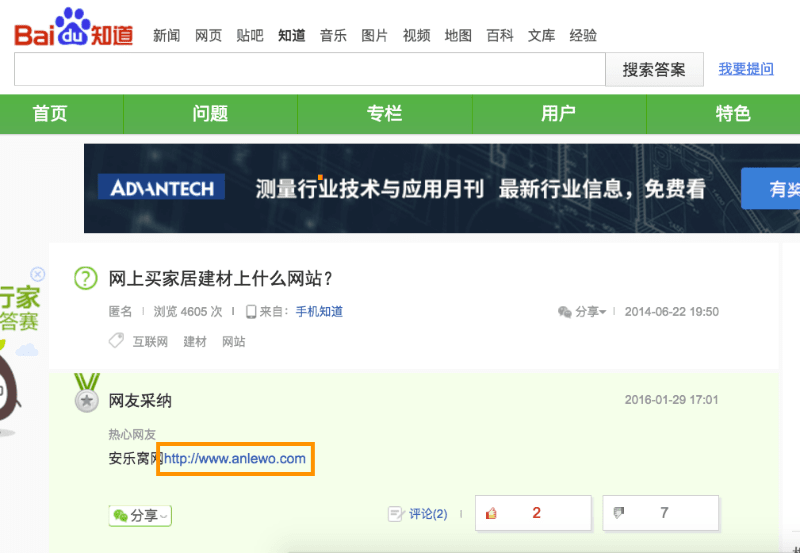
Link builders even target user generated content on Baidu’s own platforms. They utilize multiple Baidu accounts so content and links they’ve built will look natural and less likely to be removed by moderators.

It’s not uncommon to see dozens or hundreds of “Friendship Links” in the footer area of popular websites in China.
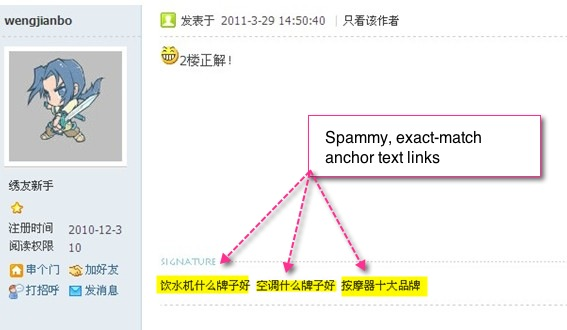
In addition to these techniques, you’ll find other classic link spam strategies such as paid links, link networks, hacked sites, buying expired domains, low-quality directories, scraping, article spinning, and comment spam all still prevalent on the Chinese web.
Check out more examples of link spam in China on the Dragon Metrics blog
Just like Google, Baidu released a link disavowal tool to prevent against negative SEO or to allow sites to recover from penalties. A couple of years later in 2015, Baidu surprised SEOs everywhere by announcing another update to their link algorithm and shutting down its link disavowal tool. They claim that from now they will only trust backlinks from a very small group of high quality websites, so therefore a link disavowal tool is now unnecessary. Baidu goes on to suggest that SEOs not to waste their time and money on link building anymore, since it will no longer be effective.
SEOs are understandably skeptical that these claims are actually true. It seems unlikely that Baidu’s algorithm is so sophisticated that link building is no longer a useful technique. However, there is likely some degree of truth to their claims. As Baidu feels it’s fighting an uphill battle against link spam, they’ve decided to try to use the “nuclear option” of ignoring links from all but the very most influential sites.
This has the unfortunate effect of the “rich getting richer and the poor getting poorer”. Larger industry-leading sites will continue to receive value from high-quality backlinks from influential sites, while mid-sized and smaller sites will not get any value at all from the types of backlinks they’re able to receive. This is evident by a distinct lack of domain diversity in Baidu’s rankings.

While some may still believe that the only way to get ahead in Baidu is to engage in low-quality link spam techniques, we strongly believe that the best long-term strategy will always be white hat, high-quality link building. The good news is that the process for link building for Baidu is not that much different than for Google. The bad news is that like link building for Google, it can be difficult and require a large amount of effort.
We believe the most effective way of white hat link building is by creating great content that can attract links by itself, without asking anyone directly to link to you. Great content typically possesses the following traits:
Self-promotional content will bore potential readers. Instead of focusing on the message you want to get across, try to offer something your customers want and can’t get anywhere else. How-to articles, in-depth guides, and witty or entertaining content will do much better in keeping reader’s attention and getting them to share and link to your content.
Think about what you can provide that others cannot. Leverage your expertise to create something truly unique.
While humor may not be right for all types of sites, good content should always be interesting and entertaining. Spice up articles with images, memes, videos, infographics, and entertaining prose to entice sharing and linkbacks.
Use the right format for your audience. While a video may be right for some sites, an in-depth guide, podcast, infographic, white paper, or games may be right for others.
Content that looks attractive will always perform better than poorly-formatted, ugly looking articles. This is one reason infographics tend to do so well.
The best way to attract high quality links to your site is to create interesting, unique, and useful content people want to share
Learn more about content creation in China in our Guide to Content Marketing
Creating quality content is only half of the game. Unfortunately, unless you’re already receiving a large amount of traffic on your site, just publishing a piece of content and waiting for links to come in probably won’t work. To maximize the effectiveness of created content, successful link builders will need to identify influencers and websites that may be interested in your content, reach out to them to begin a relationship, and influence them to link to their content. This process, known as link outreach begins with link prospecting.
Link Prospecting is the process of identifying influential people and websites in your industry that may be able to help link to your content.
Ideally, sites should be both authoritative and relevant to your content’s topic. In addition, when link building for Baidu, you want to also make sure the site is hosted in China and its content is written in Simplified Chinese. Keep in mind that since Baidu crawls non-Chinese content more slowly, less deeply, and less reliably than Chinese sites, backlinks on non-Chinese sites may not even be discovered by Baidu.
Three good places to begin with link prospecting are:
We’ll cover social media in detail next chapter, so let’s begin by talking about high-ranking sites and sites linking to competitors.

The first step to identifying popular websites in your niche is checking search engine rankings for your targeted keywords. This could be done manually, but will become extremely time-consuming when working with more than just a handful of keywords. There are many rank tracking tools out there that can automate the process for you, but we recommend using one that can automatically aggregate the highest ranking domains for an individual set of keywords. This feature is often called something similar to Competitor Discovery or Share of Voice.
In Dragon Metrics, the Competitor Discovery tool allows sites to categorize their keywords in to tightly themed groups, and will identify the top 50 domains in each group that is ranking the highest. For example, if you’re writing an article about marathon training, place all of your keywords related to this topic into one group, and Dragon Metrics will identify the most popular sites around this topic.
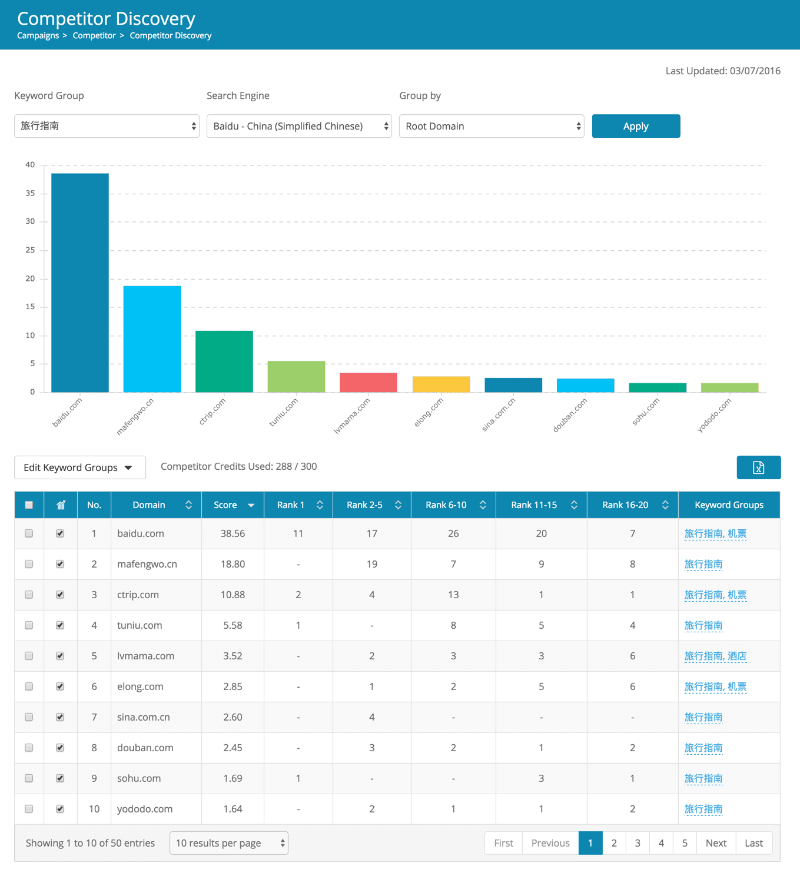
If the site is ranking well for these keywords, it’s likely that a backlink from them will help boost your rankings, but that’s not always the case. You’ll want to measure the authority of each site to see whether it’s worth getting a backlink from them or not.
There are several metrics for valuing a site’s authority. Years ago, we had Google PageRank, but as Google has stopped updating the public metric, the SEO industry is left to create its own metrics. The three major link database providers all have their own authority measures — Moz has Domain Authority and Page Authority, Majestic has Trust Flow and Citation Flow, and Ahrefs has Domain Rating and URL Rating.
These are all fantastic ways to measure a site’s authority, but one small problem is that they’re less effective at measuring a site’s authority in Baidu. In fact, Moz has specifically excluded many of the largest Chinese sites from their database. We love Moz and think their link data is great, but until they reverse this decision, we unfortunately cannot fully recommend using Domain Authority or Page Authority for Chinese sites.
Dragon Metrics has created a metric called Dragon Rank specifically for Baidu. Using Dragon Rank to evaluate a domain’s authority in Baidu can be extremely useful. In Dragon Metrics Baidu Research tool, users can browse keyword rankings and see the Dragon Rank for each site in the top 10.

If a site is already linking to a competitor, it’s very likely they may be willing to link to your site as well. In some cases, you could even look for broken links to competitor sites or content on your site that may work better than the competitor site they’re currently linking to, and try to get the link replaced with yours. Another thing to look for is lists. For most industries, there may be hundreds of Top 50 Best X lists that may be easy to get included on.
A backlink research tool like Moz, Majestic, Ahrefs, or Dragon Metrics can all help you identify which links competitor sites are getting. These tools typically list authority metrics right next to each URL, so it’s easy to identify which sites are worth getting a link from.
No need to limit your search to competitor sites either. As you collect more sites that could be willing to link to your content, try looking at their backlinks as well. Similar sites typically link to each other, and using this kind of recursive process can help discover a large number of link opportunities.
It’s a good idea to keep track of link prospects on a spreadsheet along with contact information, authority metrics, and other notes
After you’ve identified your link prospects, you will need to get in touch with them and get them to link to you. Let’s discuss a few major considerations for outreach in China.
Not all channels for reaching out to your link prospects are equally effective. Experienced outreach managers are well aware of which channels to use when conducting outreach in different circumstances in order to maximize response time and success rate.
In markets outside of China, email is typically the go-to channel for conducting outreach. In China, outreach via QQ, WeChat or phone may often be more effective. Here are 2 main reasons:
Here are our recommended outreach channels based on the types of link prospect:
These are only general guidelines — when collecting contact information, websites may list their preferred communication methods for marketing enquiries.
At their most basic level, QQ and WeChat are both instant messaging platforms. While QQ is similar to ICQ / AIM / MSN Messenger, WeChat is massive platform equivalent to WhatsApp, Facebook, and hundreds of other apps all rolled into one.
Knowledge of QQ and WeChat is very important for internet marketers in China – even if you are not planning to conduct outreach yourself, you should at least know how to install, register, add, and communicate with people on QQ and WeChat.
Begin the outreach process by finding contact information for each link prospect. Specifically, we’re looking for one or more of the following: QQ numbers (numbers are used as user IDs for QQ), WeChat IDs and Phone Numbers. If there are multiples of each, try to ascertain which one is in control content and linking if possible.
Our favorite tool for picking up link prospects’ contact information quickly is search engine search operators. Since search operators on Baidu are similar to Google, this article should provide plenty of ideas of how search queries can be used for link building.
Learn more about how search operators can be used for link building
For Example, use the following query to find contact information for article submissions (投稿) on a website:
投稿 site:{domain name}
or this URL:
https://www.baidu.com/s?wd=投稿%20site%3A{domain name}
Just change {domain name} to the domain you are trying to search for. If there are any results returned for your query, you’ll usually find contact information for article submissions on them.
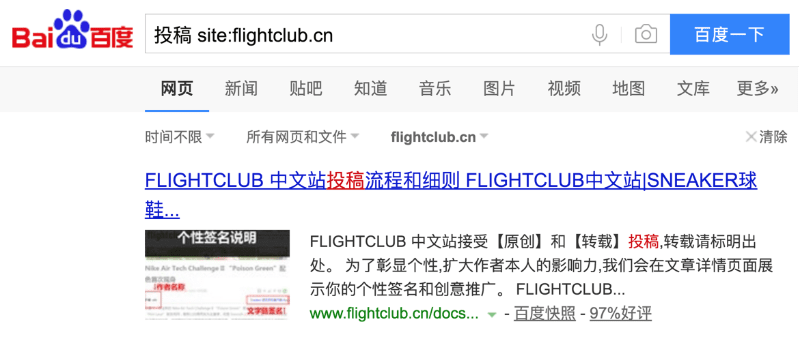
Here are a few different search operators you can use to find contact information on Chinese websites:
Find business enquiry page of a website — search using “合作” (cooperation) or “联系” (contact)
合作 site:{domain name}
联系 site:{domain name}
Find contact information of a website using “QQ”, “微信” (WeChat) or “电话” (phone number)
QQ site:{domain name}
微信 site:{domain name}
电话 site:{domain name}
After finding link prospects and their contact information, it’s time to get in touch with them. We won’t be covering the specifics of writing pitches in Chinese, but we will help explain some differences to keep in mind when communicating with China webmasters that can determine the success of your outreach.
If you’ve never done link outreach before, there are a few guidelines to follow regardless of country, language, or culture:
Further reading on outreach strategy
If you’re reaching out to a China webmaster via email, best practices don’t change other than writing your message in Chinese.
Here are some great resources on best practices for outreach:
If you’re reaching out to webmasters via messaging apps like QQ or WeChat, you’ll need to approach things slightly differently. Here are some of the most important differences and how to handle them:

If you are reaching out to personal QQ or WeChat accounts, the prospect will have to accept your contact request before you can send them messages. On both QQ and WeChat, we can include an introductory message with the contact request. This extra step introduces 2 main challenges:
Be sure your profile is filled out, attractive, and stays active. If your profile looks untrustworthy to link prospects, chances are they won’t accept your request. QQ even has a ranking system to show the age and activity level of an account, which people will definitely be using when evaluating a random contact request from a stranger.
If you approach your prospect completely out of the blue, you’ll need to craft your introductory message well enough for them to accept your contact request and see what you have to offer. The way to approach this is somewhat similar to connecting to strangers on LinkedIn. We recommend reading this article for helpful tips on how to craft the perfect message.
Check out this article to learn more about Reaching Out to a Strangers on LinkedIn
With email, people tend to expect a longer time lag before responses. This leads to more comprehensive messages and responses, trying to avoid frequent back and forth messages. If you are conducting outreach with messaging apps like QQ or WeChat, you should be prepared for more frequent and fragmented conversations. Sending a long message with all the details might not be the most appropriate style for the medium. To sound more authentic and personal, try to prepare for all the questions the prospect might have during the communication process and provide them quick responses. Knowing how to manage the quicker pace with messaging apps can make to whole link building process must faster.
High value link prospects will usually have a strong social presence both online and offline, and may be difficult to get in touch without an existing relationship. Instead, try to find where they hang out (e.g. which social networks, communities, or forums they actively participate in, which industry events they go to) and engage with them there. Participating in discussions with link prospects are a good place for a cold open and making a first impression.
Although this type of activity is time consuming and difficult to measure success in the short-term, it can land you very valuable backlink opportunities unavailable by other means. The art of building relationships in China (Guanxi) is not only an important subject for SEO, but for everyone involved in the business world of China.

Both Baidu and Google are trying their best to only reward quality backlinks. While Google is still far more advanced, Baidu continues to improve every day. Because each search engine has different standards of determining link quality, you’ll need to conduct link research specifically for Baidu. When performing link outreach, you’ll also need to be aware of the unique culture in China in order to communicate with link prospects effectively.
Chapter 6 : Mobile SEO
![]()
Chapters
Chapter 1
Chapter 2
Chapter 3
Chapter 4
Chapter 5
Chapter 6
Chapter 7
Chapter 8
Chapter 9
Chapter 10